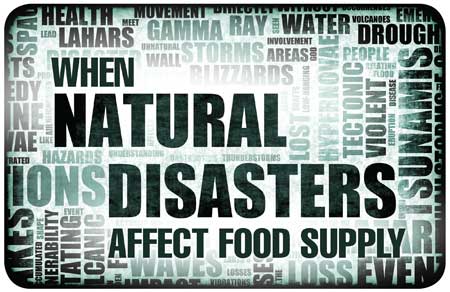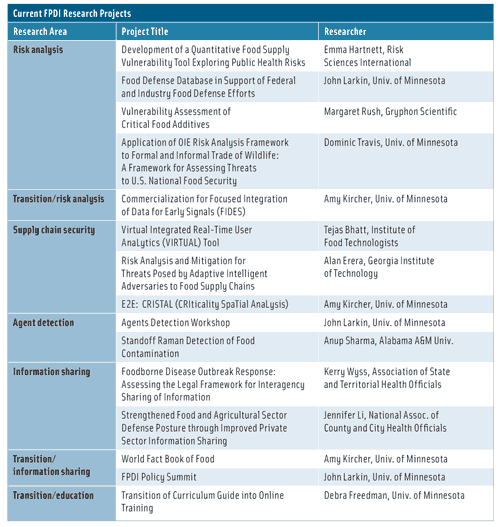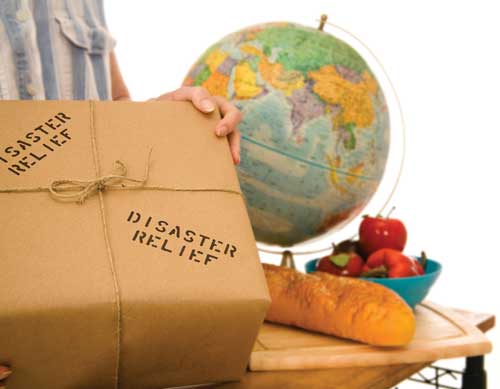When Natural Disasters Affect Food Supply
FOOD SAFETY & QUALITY
 Disasters such as earthquakes, tsunamis, and hurricanes have immediate effects on people and structures as well as secondary effects on the food system. Numerous organizations are involved in preparing for and responding to disasters, both domestic and international.
Disasters such as earthquakes, tsunamis, and hurricanes have immediate effects on people and structures as well as secondary effects on the food system. Numerous organizations are involved in preparing for and responding to disasters, both domestic and international.
Department of Homeland Security
The U.S. Department of Homeland Security (DHS) was established in 2002 by combining 22 different federal departments and agencies into a unified, integrated cabinet agency. It is the coordinator when multiple agencies are involved in a catastrophe. The Food, Agriculture, and Veterinary Defense Division of DHS leads efforts to ensure the security of the United States’ food, agriculture, human health, and animal health in the face of all hazards. The DHS works with federal, state, local, tribal, and private and public partnerships and utilizes the knowledge and experience of its Centers of Excellence.
The Federal Emergency Management Agency (FEMA) works to ensure that U.S. citizens and first responders work together to build, sustain, and improve the capability to prepare for, protect against, respond to, recover from, and mitigate all hazards. FEMA’s Protection and National Preparedness Office coordinates preparedness and protection activities; among them are grants, planning, training, exercises, and preparedness assessments. FEMA’s National Preparedness Directorate provides training through the Center for Domestic Preparedness, Emergency Management Institute, and National Training and Education Division. The National Disaster Preparedness Training Center at the University of Hawaii develops and delivers training and education in the areas of disaster preparedness, response, and recovery to governmental, private, tribal, and nonprofit entities.
The DHS offers guidance for consumers to prepare for a disaster. It also offers guidance for businesses to develop a disaster preparedness program, so they are ready to face a wide variety of hazards, including natural hazards, human-caused hazards, and technology-related hazards. Natural hazards could be a flood, hurricane, tornado, earthquake, or a widespread serious illness such as a virus pandemic. Human-caused hazards include accidents, acts of violence by people, and acts of terrorism. Technology-related hazards are the failure or malfunction of systems, equipment, or software.
The DHS indicates that companies should follow five steps in creating a preparedness program: 1) organize, develop, and administer a preparedness program and identify regulations that establish minimum requirements for the program; 2) gather information about hazards and assess risks, conduct a business impact analysis, and examine ways to prevent hazards and reduce risks; 3) write a preparedness plan addressing resource management, emergency response, crisis communications, business continuity, information technology, employee assistance, incident management, and training; 4) test and evaluate the plan and define different types of exercises, learn how to conduct exercises, and use exercise results to evaluate the effectiveness of the plan; and 5) identify when the preparedness program needs to be reviewed, discover methods to evaluate the preparedness program, and utilize the review to make necessary changes and plan improvements.
Food Protection and Defense Institute
In 2002 the DHS established a coordinated, university-based network of Science & Technology Centers of Excellence (COEs) to develop homeland security solutions and help train the next generation of homeland security experts. The consortium of hundreds of universities (which partners with industry, national laboratories, first responders, DHS operational components, science and technology divisions, other federal agencies, and state and local homeland security agencies) conducts basic and applied research addressing both short-term and long-term needs. It is also available for rapid-response efforts. Sponsored by the DHS Office of University Programs, the COEs, each focused on a unique homeland security need, perform research and development activities to provide critical tools, technologies, training, and expertise to the homeland security community.

Among the 11 current COEs and six emeritus COEs is the Food Protection and Defense Institute (FPDI), which was established at the University of Minnesota in 2004 as the National Center for Food Protection and Defense and renamed in September 2015. It provides research and education to safeguard the U.S. food system from farm to table and reduce the potential for contamination at any point along the food supply chain and a catastrophic attack on public health and the economy.
Conducted in collaborative efforts across multiple teams and organizations, the FPDI’s research falls into several categories: detection, decontamination, and inactivation technologies using research on the fundamental behaviors of select chemical or biological agents in food; dynamic, real-world modeling of food contamination events and public health responses to rapidly identify sources of contamination, food distribution points, and possible outbreak locations and to demonstrate interventions and responses using novel communication systems and actual data from food distribution, food consumption, and epidemiologic studies; information-sharing among the individuals, agencies, and companies involved in protecting the global population from food contamination; innovative strategies to assess, manage, and mitigate risk in the food supply; and strengthening supply chains by understanding system vulnerabilities, rapidly identifying disruptions, assessing risks, prioritizing protection efforts, and analyzing supply chain interdependencies.
Amy Kircher, the FPDI’s acting associate director, said that the mandate of the institute is to look at and understand threats to homeland security and how food might be affected. Since food issues are a secondary and sometimes tertiary effect of a disaster, the institute looks at the food system in total and determines where it is vulnerable and how anything catastrophic can affect it, such as a natural disaster or even a disgruntled employee adulterating food. Her research project on focused integration of data for early signals uses horizon scanning to look at the total food system for patterns, anomalies, or signals to predict or find disturbances. For example, because of the Ebola outbreak in West Africa, she said there may be a reduction in the availability of a product such as cocoa and a subsequent increase in pricing. So the project will determine a series of actions for cocoa, considering the environment and analyzing data to find the results of the disruption.
--- PAGE BREAK ---
The FPDI is not a disaster response organization, Kircher said, but a research and development arm of the DHS that develops innovative tools to help private and public groups plan for a disaster response. The FPDI may be asked operational questions, she said, such as whether the Ebola virus could come to the United States via food. A very short-time assessment was needed, and the institute was able to provide a rapid operational response. The institute also conducts risk assessments regarding food insecurity, such as determining the likely result if a government falls. Kircher organized the symposium “Global Disasters and Food: An Inextricable Collision” at IFT15. John Hoffman, FPDI’s senior research fellow, reviewed how disasters involve food safety, security, and defense; how the food industry and regulators must react with regard to risk assessment and decision making; and the impact of global disaster on the food system. He described the major problems that occurred in response to the 2011 earthquake and tsunami in Japan, the 2012 hurricane on the eastern seaboard of the United States, and the 2014 Ebola virus outbreak in West Africa and emphasized the need for better preparedness and coordination among disaster-relief organizations.
The FPDI also presents a monthly series of online webinars highlighting recent research related to food protection and defense. The webinars, which are available on the institute’s website, have covered rapid evaluation of the risk of Ebola transmission in the United States via three routes originating in West Africa—food commodities, imported wildlife, and illegal bushmeat; the work of the Institute of Food Technologists’ Global Food Traceability Center on enhancing traceability; lessons learned from the 2014–2015 H5 avian influenza outbreak in the United States; development of portable devices for detection of adulteration; potential health and security risks associated with global trade in wildlife; and educational and training programs to help industry, government agencies, and educators realize and reduce the potential for contamination at any point along the food supply chain.
With regard to what the food industry can do to prepare for disasters, Kircher said that a food company wanting to protect its product or brand name should assess its vulnerability. A company buying spices from India, for example, should assess what it would do if a disaster affected harvests, a process was disrupted, someone adulterated the product, or a transportation issue arose. How would the company mitigate those events? Does the company have alternative sources? To develop plans for alternative strategies, the company could review historical events and determine how it would handle them.
With regard to what the food industry can do to help relief efforts, Kircher said that it depends on where the disaster is located and what the company has to offer. Does the company have a unique capability or a niche product that can be useful in a particular situation? Is the company operating in a region where the disaster is occurring? The company should connect with a disaster-relief organization or other organization such as a trade group that could coordinate efforts. Besides governmental organizations such as the DHS, FEMA, and the U.S. Agency for International Development, she said that there is a host of nongovernmental organizations, ranging in size from a huge multinational group to a really small group supporting a single village or even just a team of doctors and nurses. It is impossible to know how many people will be affected by a disaster or how much of some product will be needed for relief, she said, but the response needs to be coordinated for optimum disaster relief: the right things at the right time for the right people.
 Activities of Other Organizations
Activities of Other Organizations
The Food and Agriculture Organization of the United Nations (FAO) focuses on reducing people’s vulnerability to hazards before, during, and after disasters through risk assessment, risk reduction, emergency response, and rehabilitation. Its handbook Enhancing Early Warning Capabilities and Capacities for Food Safety, published early this year, emphasizes the need to build links within the existing food safety infrastructure and to improve collaborative relationships among the different food chain stakeholders. The FAO’s Emergency Prevention System for Food Safety unit works to prevent and manage global food safety events and emergencies. In collaboration with the World Health Organization, the unit has been developing a five-year strategy to help countries build and enhance early-warning capacities in food safety and to establish global early warning food safety networks.
The U.S. Agency for International Development responds to all types of natural disasters in partnership with corporations, nongovernmental organizations, scientists, U.S. government agencies, the military, humanitarian organizations, in-country partners, small businesses, people dispersed from their homeland (diasporas), universities, and faith-based and community organizations. It focuses on disaster prevention, response, recovery, and transition, helping states and communities prepare for and mitigate the impacts of disasters and providing humanitarian and emergency food assistance. The agency supports a range of disaster risk-reduction activities, including early warning systems and analysis of hazards and vulnerabilities. Its Office of U.S. Foreign Disaster Assistance works to reduce disaster risk by prioritizing and strengthening early warning, preparedness, mitigation, and prevention.
The World Health Organization of the United Nations coordinates the health response during emergencies, undertaking risk assessments; identifying priorities; setting strategies; providing critical technical guidance, supplies, and financial resources; and monitoring health situations. The World Health Organization’s Early Warning and Response System project is an initiative to catch disease outbreaks early to be able to contain them in emergencies.
UNICEF delivers assistance to children and their families around the world before, during, and after an emergency. It partners with governments, United Nations agencies, international financial institutions, and global programs and works closely with multinational corporations, national companies, and small- to medium-sized businesses to identify, design, and implement alliances that leverage the strengths of the corporate sector.
The World Food Program (WFP), the world’s largest humanitarian agency fighting hunger, responds to disasters such as earthquakes, floods, and tsunamis. Within 24 hours of receipt of a request for help from the government of an affected country, the WFP mobilizes relief teams, gathers data/maps, locates the nearest emergency food rations, and alerts logistics and telecommunication experts around the globe. Within 48 hours, it establishes an emergency operations center, coordinates first deliveries/distributions, defines a plan for initial response, and drafts logistics experts to transport food and telecommunication experts to set up communications. Within one week, it designs a comprehensive emergency operation, buys food needed for relief operation, sets up aid-transport channels, and launches an international appeal for funds. Within three months, it organizes regular distributions in affected areas, sets up monitoring systems for distributions, assesses the need for extension of the emergency operation, and integrates specialized food products to combat malnutrition.
The American Red Cross prevents and alleviates suffering by all people affected by disaster across the United States and around the world by mobilizing volunteers and donors. In an emergency, there are always trained individuals nearby. The organization also trains people on how to respond to and prepare for emergencies. Courses covering all key areas of training are available online and in classrooms. The organization is the leading provider of OSHA-compliant health and safety training for all types of emergencies and provides food safety guidelines for consumers and industry.
 Neil H. Mermelstein, IFT Fellow, Editor Emeritus of Food Technology
Neil H. Mermelstein, IFT Fellow, Editor Emeritus of Food Technology
[email protected]


